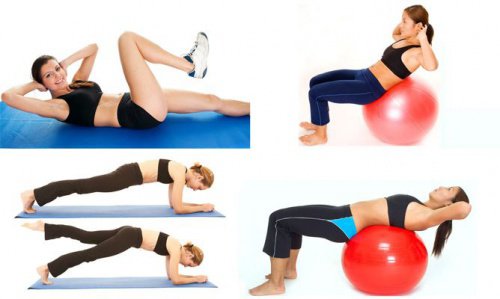Types of Ab Exercises and Their Benefits

There are many myths and a lot of misinformation surrounding this popular exercise of abdominal crunches. Some say that you should not do ab exercises every day, while others say that doing so will get you closer to your goal of a slim waist. There are those who argue that for them to have any effect at all, you have to do at least 1,000 crunches in each routine. Find out in the following article what types of ab exercises there are and what each of them accomplish.
Tips for performing ab exercises
Before learning what different types of ab exercises exist, it’s good to learn some basic points about them. The most important aspect of the exercise is doing it correctly. But what’s the proper way to do abdominal exercises?
For one, you must be very careful with the back and the neck, which are the two regions most affected by bad technique. Your arms should be as open as possible so that the crunch is done by the muscles of the stomach and not another part of the body.
Moreover, you should realize that this none of the types of ab exercises target belly fat. The most effective way to reduce fat is aerobic exercise combined with a good diet.
Instead of doing a lot of one kind of abdominal exercise in the same routine, you should do several different kinds for each type of muscle. Experts usually identify the three areas as the obliques, upper abdominals, and lower abdominals.

In order to improve, you should work muscles several days a week, but also give them some days of rest. If they are overworked, muscle fatigue and injuries may occur. If you are working the upper muscles or the oblique muscles, you should not bend the head or jerk your arms when lifting your body up.
See Also: Exercises to Define and Tone Muscles
Why is it important to do ab exercises?
To prevent back pain
Exercise is the most effective treatment for neck pain, back pain, and several other types of pain. But be careful, as it should always be a specific activity that doesn’t damage the area further. As long as you don’t have a major illness in your spinal column, ab exercises can make your back stronger.
To improve body posture
If your abs are strong, not only will it help define your figure, but it will also improve your posture by keeping your body upright. On the contrary, when you have weak abs, you tend to hunch your back and shoulders forward, which creates additional pain.
To combat swelling
The abdominals serve to flush toxins fats, end excess fluid, from the body. They keep the stomach and intestines in top form. If you have toned abdominal muscles, the intestines can do their job better and you’ll help reduce constipation.

To prevent sagging
Having well-defined abs is, of course, very important to physical beauty. These exercises help you to combat the sagging that often occurs after pregnancy or the abrupt weight loss. This can weaken the tissue with the passage of time. Ab exercises can help you look your best.
What are the different types of ab exercises?
The following types of abdominal exercises are those that you probably do without even realizing it. Pay attention to each one of them and find out what happens when you do them.
Standard Ab Exercises
The standard abdominal exercises are one of the types of ab exercises where the movement “isolates” the abdominal muscles. In other words, only that part is worked during these exercises.
To do them, you lie on your back with your feet flat on the floor and knees bent. You can also do them with your legs straight, raised or resting on a bench. Your hands should meet behind your head.
Flex your stomach muscles and raise your body up as high as possible, keeping your lower back pressed to the floor or mat. Return to the starting position.
Ab exercises with ropes or a band
The elastic band contracts and in doing so it gives resistance to the movement and crunching of the abdominals. You need to kneel under a pulley with a rope or band. Hold it with both hands and pull down, behind your neck, until your hands come to your chin level.
Then bend your hips and allow the weight to straighten your back. Lean forward slightly to contract the muscles. Pull the elbows out. Keep your hips still and maintain the tension all the time.

Ab exercises with thrust
These are performed with dumbbells or a barbell. Lie on a steeply inclined bench with your back to it. To keep from moving, lock your feet in place and take the dumbbell or plates (with or without the bar). Stretch out your arms to your sides. Lean forward to lift the upper torso as high as possible. Then return to the starting position.
Also Read: 5 Exercises to Tone Arms
Ab exercises with a stability ball
This is a very interesting exercise that allows you to activate the lower part of the abdominals and also have more strength in the torso by activation of certain muscle groups.
To perform these abdominal exercises, you must sit on a ball and walk your feet forward, twisting with your back. Bend your hips and knees, letting your head and shoulders hang. Place your hands behind your head and bend forward to the waist level. Keep your lower back against the ball.
Reverse abdominals
These serve to increase the strength in the lower part of the abdomen. You must lie down with your legs and arms outstretched. Your palms are flat on the floor. Raise your legs until they are perpendicular to the ceiling.
Raise and lower the legs without bending and without ever touching the floor. Another option is to bring your knees to your chest and stretch your legs until they are parallel to the floor.
Abdominals with a twist

These types of ab exercises serve to work the oblique abdominals. These are muscles at the sides of the waist. Lie on your back, with knees bent and feet supported on the floor. Then put your hands behind your head.
Lift yourself as if you’re going to do the standard ab workout, but instead or rising straight all the way, turn your torso to the right as you come up. Lower yourself and repeat by twisting to the left. Remember to always keep your elbows apart.
All cited sources were thoroughly reviewed by our team to ensure their quality, reliability, currency, and validity. The bibliography of this article was considered reliable and of academic or scientific accuracy.
ESCAMILLA, R. F. (1996). Core Muscle Activation During Swiss Ball and Traditional Abdominal Exercises. Journal of Athletic Training. http://doi.org/10.2519/jospt.2010.3073
This text is provided for informational purposes only and does not replace consultation with a professional. If in doubt, consult your specialist.








